

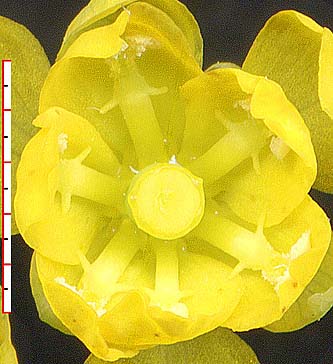 |
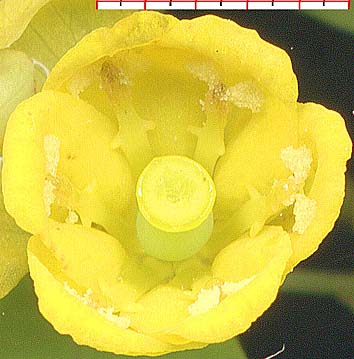 |
| B. swaseyi | hybrid |
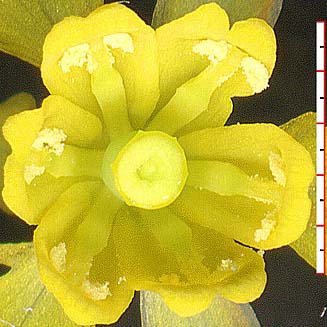 |
|
| B. trifoliolata | |
| Stamens & petals of Berberis in Hays County | |
Stamens of our Berberis species generally conform to the generic descriptions of 19th Century botanists. Each flower has 2 whorls of 3 petals, each with a stamen adnate to its base flanked by nectaries, one on each side. Viewed from the side the stamen traces a sigmoid curve, the filament initially bending in toward the ovary and then bending away at the juncture with the connective. (The stamens in the image below have additionally reacted to stimulation, bending as a unit toward the pistil, without, however, changing their general curvature - see Irritable Stamens.) With our species the normal (non-stimulated) stamen is essentially embedded in the concave petal surface and is taller than the pistil.
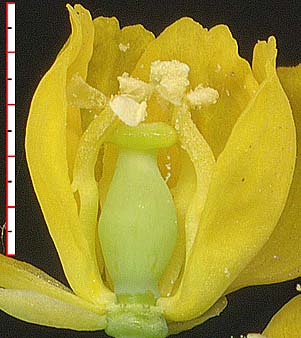
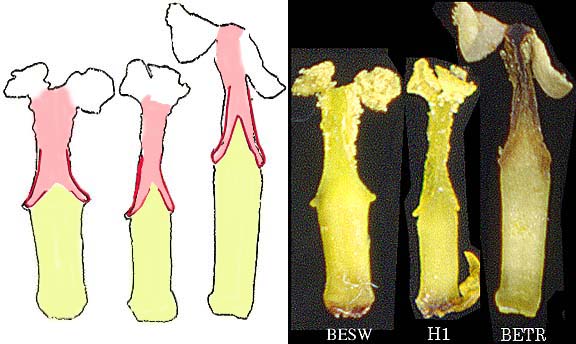
Cross sections of a B. swaseyi stamen show that it is roughly twice as wide as thick (0.45 mm X 0.22 mm, although its width swells by 0.15-0.25 mm. at the point of the appendage.
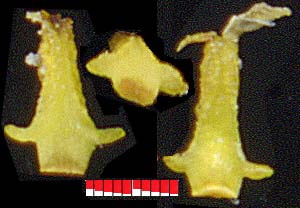
The anthers are adnate to the apex of the connective, and open extrorsely by valves which swing open from the bottom to the top. The pollen mass adheres to the uplifted valves, which are closely appressed to the petals. The closed anthers, as in state (1) below, are noted only when buds are dissected - note the immature petals. In the image the filament proper is 2 mm high; the connective, 1.75 mm. As soon as the flower opens, the anthers open fully, and the valves quickly shrink in size. The B. trifoliolata valve prior to opening is c. 1.6 mm; after opening, 1 mm.
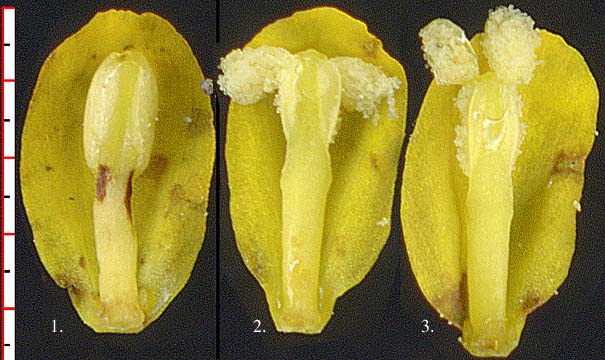
The uplifted valves, initially laden with pollen, present a distinctive shape and orientation with respect to the stamen apex. Those of B. swaseyi are round and rise above the stamen, pivoting so that the inner valve surface is parallel with the petal and facing the pistil; those of B. trifoliolata assume a nearly triangular form and are projected at right angles just below the very tip of the stamen. The stamen apex itself is distinctive: B. trifoliolata being a distinctly produced and rounded; B. swaseyi, truncate with slight central depression between the valve attachments. Hybrids showed considerable variation in these features: H23 has clear B. swaseyi forms; H4 valves and orientation are close to B. trifoliolata, but the apex is not produced; H29 would appear to be intermediate in type.
Two exceptions to the B. swaseyi patterns were plants FC17 & S13, with angular valves. With FC17 I noted that its teeth were also unusually short for B. swaseyi - a feature I associate with introgressive hybridization reverting to B. Swaseyi. But then I found S13 with more usual long, flexuous teeth and again S16 with very typical swaseyi valves and very short teeth. In my opinion, these exemplify three different stages of introgressive hybridization.